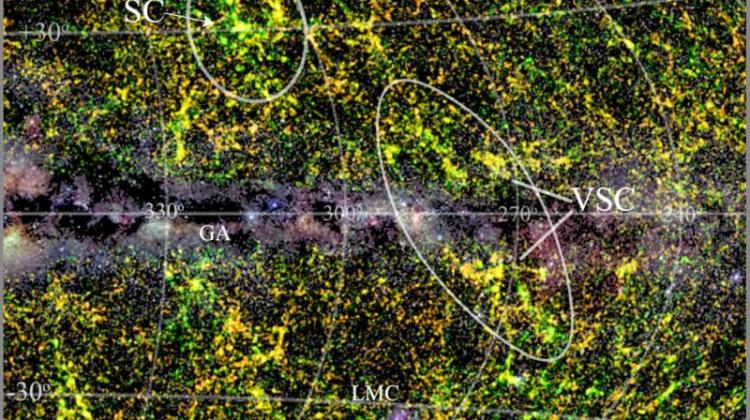Discovery of a supercluster of galaxies hidden by Milky Way

An international team of astronomers with the participation of Polish scientist has discovered a previously unknown supercluster of galaxies in the constellation Vela, partially hidden in the sky behind the Milky Way. The discovery was reported by the University of Cape Town (South Africa) and Leiden University (Netherlands).
Superclusters of galaxies are the largest and most massive structures in the universe. They consist of clusters of galaxies, concentrations of hundreds or thousands of galaxies. Their sizes can reach 200 million light years. In the universe they are distributed in the shape of great cosmic web, forming "walls" surrounding giant cosmic void. The most massive supercluster known in our local universe is the Shapley supercluster, discovered by Harlow Shapley in 1930. It is located 650 million light years from us.
Another, previously unknown, large supercluster of galaxies in the constellation of Vela was discovered recently by a research group from South Africa, the Netherlands, Australia and Germany, with the participation of Polish astronomer working in the Netherlands. It is located at the distance of 800 million light years from Earth, and in the sky covers a greater area than the Shapley supercluster.
The discovery was based on multi-object spectroscopic observations of thousands of galaxies. Observations in 2012 with the SALT telescope in South Africa (in which Poland has a partial share) confirmed that eight new clusters reside within the Vela area. Subsequent spectroscopic observations with the Anglo-Australian Telescope (AAT) in Australia provided thousands of galaxy redshifts and revealed the vast extent of this new structure.
Dr. Maciej Bilicki from the Observatory in Leiden (Netherlands) dealt mainly with the theoretical part of the research: estimating counts of galaxies and superclusters density, as well as its impact on the movement of the Local Group, which is the nearest to us clusters of dozens of galaxies, to which the Milky Way belongs.
The discovery of a large supercluster of galaxies in our cosmic environment is important in the cosmological context. This type of huge concentrations of mass strongly affect their environment in a large area.
"Despite the considerable distance from us, the Vela supercluster can have a significant impact on the movement of the Local Group. We hope that it will allow to solve mysteries of observed movements of galaxies around us" - said Dr. Bilicki.
The existence of the Vela supercluster could be confirmed only now due to its location partly behind the plane of the Milky Way. Polish astronomer explained that obstacles in the study of this area are dust and stars in our Galaxy, and the closer to the galactic equator, the better they cut off the extragalactic signal, especially in the optical and ultraviolet range, but also in the infrared range. In addition, nearby there is one of the brightest X-ray sources - supernova remnant in Vela - which effectively hinders or even prevents X-ray measurements used to look for clusters of galaxies.
Dr. Bilicki reminded in an interview with PAP that for at least a decade scientists had suspected that something existed in that area. The first indications were obtained from the photometric counts of infrared survey 2MASS and scans of the photographic plates. In addition, analysis of the cosmic flows, such as the movement of the Local Group, suggested the existence of a mass cluster in the area. Unfortunately, the area was virtually not examined at all in three dimensions, until the spectroscopy campaign. "And without spectroscopic measurements we could not confirm that there was in fact a supercluster of galaxies there" - said Dr. Bilicki.
As if there weren\'t enough obstacles in space, the earthly nature wasn\'t making things easy for researchers. When they received observation time on the AAT telescope in 2013, a great bush fire prevented observations and they had to wait a year to perform observations.
"Then we still had to analyse the data and convince ourselves that this was in fact not a random grouping of small amounts of galaxies, but an actual supercluster - of which we now have strong evidence. But it seems that the final verification of how large the structure is will be possible only through radio observations of neutral hydrogen, with instruments such as the MeerKAT and ASKAP" - added Dr. Bilicki.
In the publication, scientists refer to the Vela supercluster as Terra Incognita. This Latin term used in cartography means "unknown land", a white spot on the map. Researchers graphically compare the supercluster to a large, unknown continent that science is just beginning to explore. They announce further research to find out how big the supercluster is and determine its cosmological significance.
The results are described in an article, which will appear in the scientific journal "Monthly Notices of the Royal Astronomical Society - Letters". The research group is headed by Prof. Renée C. Kraan-Korteweg of the University of Cape Town.
PAP - Science and Scholarship in Poland
cza/ zan/
Przed dodaniem komentarza prosimy o zapoznanie z Regulaminem forum serwisu Nauka w Polsce.















